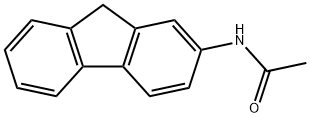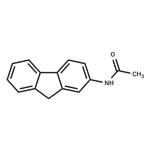2-Acetylaminofluorene (2-AAF) was originally synthesized to
be used as a pesticide but due to its profound carcinogenicity it
is now purely used in research laboratories for research
purposes only. The occupations at greatest risk to acetylaminofluorene
exposure are organic chemists, chemical stockroom
workers, and biomedical researchers. 2-AAF is a tan-colored
compound insoluble in water (melting point. 194 �C). It is
soluble in glycols, alcohols, ether, and acetic acid. 2-AAF is no
longer produced in commercial quantities anywhere in the
world. In 2009, 2-AAF was distributed in small quantities by 17
specialty chemical companies, including 11 in the United
States. As per the US Environmental Protection Agency (EPA),
environmental release of 2-AAF rose from w10 000 to
w81 000 lb from 1998 to 2001, and then was contained below
1000 lb in 2003. Although neither the National Institute of
Occupational Safety and Health (NIOSH) nor the Occupational
Safety and Health Administration (OSHA) has estimated
the number of US workers exposed to acetylaminofluorene,
perhaps fewer than 1000 workers in 200 laboratories may have
come in contact with this compound.
In order to debate ‘threshold level,’ dose–response relationships,
and carcinogenic potential of 2-AAF, a few studies
employed very large numbers of female BALB/c StCrlfC3Hf/
Nctr mice, and exposed them to low doses of 2-AAF for up to
33 months. Study findings showed two different types of dose–
response relationships for urinary bladder neoplasms and liver
neoplasms; bladder neoplasms exhibited a minimum effect
level (or a nonlinear response) for specific conditions. In
contrast, the late-appearing liver neoplasms displayed a nearly
linear response that extrapolated directly to zero dose. Time of exposure (18, 24, and 33 months) was shown to be an
important factor for incremental positive response. Induction
of bladder neoplasms was shown to occur early in the study,
but was dependent on the continuous presence of 2-AAF,
whereas the liver neoplasms appeared very late in the study but
were shown to be induced at a very early point in the exposures
and did not require the continuous presence of the carcinogen
in order to develop. Results of this type of studies were
consistent with ‘no threshold concept.’ Overall, most studies
advocate the importance of the time factor in safety evaluation
or risk assessment in carcinogenesis because carcinogen dose,
length of exposure, and gender all may play roles in cancer/
tumor development.
WHITE TO YELLOW-BROWN CRYSTALLINE POWDER
2-Acetylaminofluorene (AAF) is a combustible, tan powder or crystalline solid
Acetylaminofluorene is found as a contaminant in coal gasification
processes. It was intended to be used as a pesticide but
was never marketed due to its carcinogenicity. It has no known
use.
As a laboratory reagent for research purposes (specifically, a positive control for carcinogenicity
and mutagenicity studies)
N-(2-Fluorenyl)acetamide (2-Acetamidofluorene, 2-AAF), a genotoxic carcinogen, is used to induce liver cancer in animal models such as the 2-AAF/partial hepatectomy rat. 2-AAF may be used to study the mechanism of liver carcinogenesis and as a reference material during its identification or quantitation.
As a positive control to study the carcinogenicity and mutagenicity of aromatic amines.
ChEBI: The parent of the class of 2-acetamidofluorenes, being an ortho-fused polycyclic arene that consists of 9H-fluorene bearing an acetamido substituent at position 2. It is a carcinogenic and mutagenic derivative of fluorene.
2-Acetylaminofluorene is produced for research purposes
only with an estimated U.S. annual usage of less than 20
lb. It was originally developed as a possible insecticide
but has never been used for this purpose after discovery of its
carcinogenicity. It is now almost exclusively used in the
laboratory studies as a model carcinogen and mutagen.
White powder or light beige solid.
2-ACETAMIDOFLUORENE is incompatible with acids, bases and oxidizing agents. Ozone and chlorinating agents oxidize 2-ACETAMIDOFLUORENE .
2-Acetylaminofluorene (AAF) is
a potent carcinogen in dogs, hamsters, and rats.
There is no toxicity information on
humans.1
Flash point data for 2-ACETAMIDOFLUORENE are not available; however, 2-ACETAMIDOFLUORENE is probably combustible.
A genotoxic carcinogen that is used to model liver carcinogenesis in rat. When N-hydroxylated by cytochrome CYP1A2 in the liver, 2-AAF forms adducts with DNA and is tumorigenic in liver and bladder.
Confirmed human
carcinogen with experimental carcinogenic,
neoplas tigenic, tumorigenic, and teratogenic
data. Moderately toxic by ingestion and
intraperitoneal routes. Experimental
reproductive effects. Human mutation data
reported. When heated to decomposition it
emits toxic fumes of NOx.
2-AAF was intended to be used as a pesticide, but it was never marketed because this chemical was found to be carcinogenic. AAF is used frequently by biochemists and technicians engaged in the study of liver enzymes and the carcinogenicity and mutagenicity ofaromatic amines as a positive control. Therefore, these persons may be exposed to AAF.
2-Acetylaminofluorene is reasonably anticipated to be a human carcinogen based on sufficient evidence of carcinogenicity from studies in experimental animals.
Biological. In the presence of suspended natural populations from unpolluted aquatic systems,
the second-order microbial transformation rate constant determined in the laboratory was reported
to be 4.8 ± 2.8 x 10-12 L/organism?h (Steen, 1991).
Chemical/Physical. Based on first-order rate constants determined at 85.5 °C, hydrolysis halflives
at pH values of 2.49, 2.97, 7.34, 9.80, 10.25, and 10.39 were 4.2, 12, 41, 13, 7.2, and 1.9 d,
respectively (Ellington et al., 1987). Releases toxic nitrogen oxides when heated to decomposition
(Sax and Lewis, 1987).
UN3077 Environmentally hazardous substances, solid, n.o.s., Hazard class: 9; Labels: 9-Miscellaneous hazardous material, Technical Name Required.
Recrystallise it from toluene (1.3mg in 100mL). Its solubility in H2O is 1.3mg/L at 25o, UV: max nm(log ) : 288(4.43), 313(4.13). [Sawicki J Org Chem 21 271 1956.] It can also be recrystallised from 50% AcOH. [Diels et al. Chem Ber 35 3285 1902]. 9-14C and -14C 2-acetamidofluorene were recrystallised from aqueous EtOH and had m 194-195o and 194o respectively. Potent CARCINOGEN. [Miller et al. Cancer Res 9 504 1949, 10 616 1950, Sadin et al. J Am Chem Soc 74 5073 1952, Beilstein 12 H 3287, 12 IV 3373.]
According to the US EPA’s Toxics Release Inventory, environmental
releases of 2-AAF considerably increased from 1998 to
2001, declined to as low as 255 lb in 2003, and have remained
below 1000 lb since 2003. However, most of the releases were
to hazardous-waste landfills. In 2007, one facility released
about 500 lb of 2-AAF to a hazardous-waste landfill and about
250 lb to air. Release of 2-AAF to the environment from artificial
sources is probably not significant since less than 20 lb
year of this compound are consumed in the United States.
If released to soil, 2-AAF is expected to have low mobility.
Chemical hydrolysis, oxidation, and volatilization are not
expected to be significant. If released to water, 2-AAF may
undergo direct photolysis and is expected to strongly adsorb to
suspended solids and sediments. Chemical hydrolysis, oxidation,
volatilization, and bioaccumulation are not expected to
be significant. If released to the atmosphere, 2-AAF may
undergo vapor phase adsorption to airborne particulate matter,
it may react with photochemically generated hydroxyl radicals
(estimated vapor phase half-life1/4 5.92 h) or it may undergo
direct photolysis.
Hygroscopic. Contact with strong oxidizers may cause fire and explosions. Not compatible with cyanides, acids, and/or acid anhydrides. May form unstable and explosive peroxides; a possible polymerization hazard. Contact with strong oxidizers or strong reducing agents may form flammable gases and cause fire and explosions. A weak base that may react as an acid. Incompatible with strong bases (forming potentially dangerous salts), chlorinated hydrocarbons, nitro compounds. Reacts with azo and diazo compounds, generating toxic gases. Contact with mixture of acetic acid 1 dinitrogen trioxide may cause explosion.
Consult with environmental regulatory agencies for guidance on acceptable disposal practices. Generators of waste containing this contaminant (≥100 kg/mo) must conform with EPA regulations governing storage, transportation, treatment, and waste disposal. Presumably high-temperature incineration with scrubber for any produced nitrogen oxides can be used


